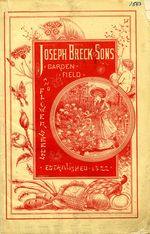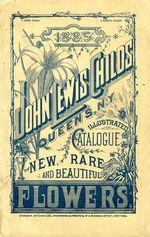The jury is still out in terms of who introduced the first color illustrations in U.S. seed catalogues. One reason for the confusion may have to do with the definition of what various authors have meant by the terms “catalogue” and “color illustration”. Many companies produced informative garden books, calendars, almanacs, and magazines which included catalogues of seeds for sale, and these seem to have contained color illustrations before free mail order pamphlet catalogues did. For example, Landreth’s Rural Register and Almanac contained color plates of onions in the late 1850s. Gradually, more companies began including color illustrations to their pamphlet catalogues starting in the mid to late 1860s.
B.K. Bliss, James Vick, and Henry Dreer have all been credited as having introduced the first color illustrations in U.S. seed trade catalogues. A thorough study of surviving catalogues would verify or refute these claims. U.P. Hedrick wrote that B.K. Bliss published the first color plates in 18531; however, in the National Agricultural Library’s collection, B.K. Bliss’ seed catalogue of 1866 contains black and white engravings only, as does a seed catalogue of 1867 in the library of the University of Delaware. In the NAL collection, Bliss’ autumn catalogue for 1867-8 contains a color lithograph of a lily, tulip, and double hyacinth, suggesting that he introduced color in late 1867. His seed catalogue of 1870 (in the NAL collection) illustrated pansies in a color plate by Milton Bradley of board game fame, who operated a lithography shop near the Bliss establishment on Main St. in Springfield, Massachussetts. It is possible that Hedrick may have been referring to a larger publication by Bliss which may have included a catalogue.
An advertisement for James Vick’s 1864 catalogue promotes “a splendid color plate of the Double Zinnia”2. His Floral Guide of 1866, in the OSU collection, had a color plate by George Frauenberger that is missing, but his edition of 1871 contains two chromolithographs of petunias, by Adolphe Nolte of Rochester, New York. “To aid in the development of floral taste”, Vick also offered a 2’x18” annual chromo of 30 flower varieties which he wrote would make “a very fine parlor ornament”. Henry A. Dreer is said to have introduced color in his bulb catalogue of 18653.
Color had appeared earlier in nursery sample plates, which were used by traveling salesmen to sell fruit. Many of these were produced in Rochester, an important center for fruit-tree growing and then of horticultural printing in the mid-19th century. Several firms in that city produced many of the late 19c. chromolithographs in seed and nursery catalogues.4
The OSU collection contains several examples of other catalogues from the 1880s by influential authors on flowers, who might be expected to have introduced color illustrations as early as possible: Joseph Breck and John Lewis Childs. Their color plates are included in the other scans of their items, click the covers to view.
Notes
- U.P.Hedrick, A History of Horticulture in America to 1860, (New York, Oxford University Press, 1950) 250 says “…the Bliss company was the first seed firm to print a catalogue with colored plates, the earliest of which appeared in 1853”. This catalogue is not known to have survived.
- American Agriculturist, Volume 23, (New York, Orange Judd A.M. January 1864) 173. Available online here.
- “Seed Trade in America before the ASTA,” Seed World, May 1983: 21-22
- For more information on nurserymens’ sample plates: Van Ravenswaay, Charles, Drawn from Nature: The Botanical Art of Joseph Prestele and his Sons, (Washington, D.C., Smithsonian Institution Press, 1984). See also, the University of Delaware Special Collections site http://www.lib.udel.edu/ud/spec/exhibits/hort/seeds.htm and Karl Kabelac, “Nineteenth-Century Rochester Fruit and Flower Plates, University of Rochester Library Bulletin XXXV, 1982 at http://www.lib.rochester.edu/index.cfm?page=2397


